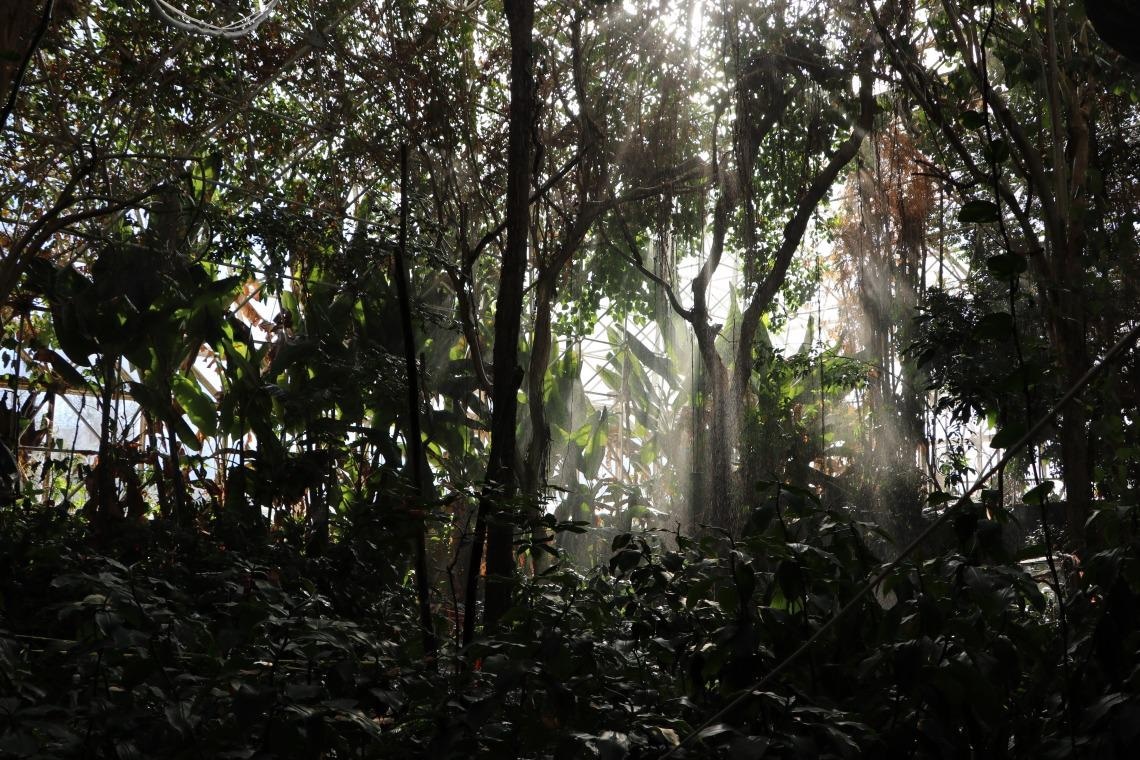A group of 80 international research scientists aimed to complete an unprecedented experiment wherein they forced the world's only enclosed rainforest, located in the University of Arizona's Biosphere 2, through a controlled drought and recovery for a period of four months.
 The "rainforest under-glass" at Biosphere 2 receives rain after a 2-month drought as part of the B2 WALD experiment. (Image Credit: Rosemary Brandt).
The "rainforest under-glass" at Biosphere 2 receives rain after a 2-month drought as part of the B2 WALD experiment. (Image Credit: Rosemary Brandt).
This unique experiment would help paint a better picture of how climate change worldwide will impact the Earth's ecosystems.
Their findings, reported recently in the journal Science, revealed an approximately 70% decrease in the rainforest's carbon storage – speaking to concerns relating to the forests' ability to collect and store carbon dioxide from the air as climate change advances. However, a complex web of water-use strategies and soil interactions were discovered to support the forest's stability when faced with extreme drought.
"The forest was, in some ways, surprisingly resilient to the drought," said Laura Meredith, one of three leads on the project and an assistant professor in the School of Natural Resources and the Environment in the College of Agriculture and Life Sciences.
The glass-enclosed rainforest at Biosphere 2, which is host to 90 plant species spanning an area the size of seven tennis courts, allowed the scientists to mimic a total ecosystem drought.
The experiment, called Water, Atmosphere and Life Dynamics – or WALD, which in German means "forest" – aimed to collect every bit of data possible during the drought and rewet process.
Approximately 2 miles of Teflon tubing and over 133 sensors were positioned all over the roughly 3-acre rainforest to instantaneously capture measurements on everything ranging from carbon pools in the atmosphere and vegetation, to deep-water soil processes and microbiome.
We used stable isotopes to trace the movement of carbon and water through the ecosystem under normal conditions and severe drought, which revealed surprising plant-ecosystem interactions.
Laura Meredith, Project Lead and Assistant Professor, School of Natural Resources and Environment, College of Agriculture and Life Sciences, University of Arizona
"Importantly, individual plants did not all respond to drought in the same way. Some were highly drought sensitive and quickly slowed their critical carbon and water cycling to play it safe, while others were more tolerant of drought and maintained their function even under more risky drought conditions," Meredith added.
In their experiment, the team classified the reactions of the plants by their drought tolerance and drought sensitivity in both undergrowth species and large canopy trees.
We observed one of the most astonishing reactions between the large, drought-tolerant and drought-sensitive trees.
Christiane Werner, Project Lead and Professor of Ecosystem Physiology, University of Freiburg
Large, drought-sensitive trees typically guzzle the most water, particularly from the topsoil. As the topsoil was the first to dry out during the drought, these trees suffered the fastest and most severely from insufficient water, explained Werner. The scientists anticipated drought-sensitive trees would instantly draw from the water resources in the deep soil.
Instead, they drastically reduced their water consumption and only resorted to their deep-water reserves under very extreme drought. In this way, they conserved the deep-lying water reserves for as long as possible.
Christiane Werner, Project Lead and Professor of Ecosystem Physiology, University of Freiburg
Large, drought-tolerant trees tended to hold onto their canopy leaves for the longest period, offering sustained shade and sparing the undergrowth from additional topsoil dehydration.
Having a diversity of drought responses within the plants helped maintain greater carbon and water cycling functions of the entire ecosystem, both during the fullest extent of drought, as well as for quickly responding to the renewed availability of moisture with the arrival of rain.
Laura Meredith, Project Lead and Assistant Professor, School of Natural Resources and Environment, College of Agriculture and Life Sciences, University of Arizona
While carbon storage in the forest system dropped considerably under growing drought stress, plants emitted more volatile organic compounds, or VOCs, which are a part of communication and signaling among plants and soil microbes. VOCs are mainly vital in how plants handle stress.
According to the outcomes, there was a flow of emissions of a variety of VOCs, including hexanal, isoprene and monoterpenes, the last of which can assist cloud condensation and rain formation and may act as a shield against drought.
While plants were robust emitters of VOCs to the atmosphere, microbial life in the soil captured some of those compounds, lessening the maximum amount that would be discharged to the atmosphere above a tropical rainforest.
"This counterbalancing role of soil microbes to plant VOC emissions persisted, even under severe drought, indicating that we need to take the role of microbial activity on atmospheric processes better into account," Meredith said.
The WALD research team carries on working through the data derived from the experiment and is currently looking at the ecosystem's smallest scale, microbial life. The team is focused on defining mechanisms of carbon and water cycling at these small scales by recording the genomic and metabolomic profiles of soil and root microbiomes.
"Experimental ecosystems, like what we have at Biosphere 2, allow researchers to understand the holistic response of an entire ecosystem to stress," Meredith said. "As we work to understand and predict ecosystem function in response to global change, we have to consider plant functional groups and their interactions with soils and the atmosphere, in both observational and modeling studies."
Journal Reference:
Werner, C., et al. (2021) Ecosystem fluxes during drought and recovery in an experimental forest. Science. doi.org/10.1126/science.abj6789.